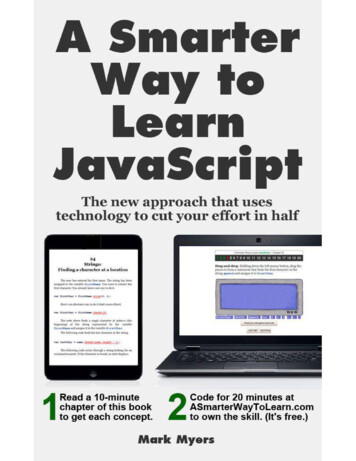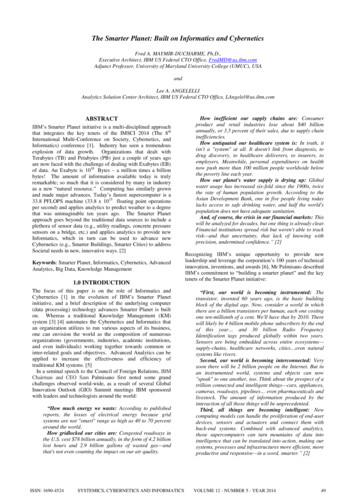
Transcription
A Smarter Way to Learn JavaScriptThe new approach that uses technology to cut your effort in halfMark Myerscopyright 2013 by Mark Myers2
Chapters1. Alerts2. Variables for Strings3. Variables for Numbers4. Variable Names Legal and Illegal5. Math Expressions: familiar operators6. Math Expressions: unfamiliar operators7. Math Expressions: eliminating ambiguity8. Concatenating text strings9. Prompts10. if statements11. Comparison operators12. if.else and else if statements13. Testing sets of conditions14. if statements nested15. Arrays16. Arrays: adding and removing elements17. Arrays: removing, inserting, and extracting elements18. for loops19. for loops: flags, Booleans, array length, and breaks20. for loops nested21. Changing case22. Strings: measuring length and extracting parts23. Strings: finding segments24. Strings: finding a character at a location25. Strings: replacing characters26. Rounding numbers27. Generating random numbers28. Converting strings to integers and decimals29. Converting strings to numbers, numbers to strings30. Controlling the length of decimals31. Getting the current date and time32. Extracting parts of the date and time33. Specifying a date and time34. Changing elements of a date and time35. Functions36. Functions: passing them data37. Functions: passing data back from them38. Functions: local vs. global variables39. switch statements: how to start them40. switch statements: how to complete them3
41. while loops42. do.while loops43. Placing scripts44. Commenting45. Events: link46. Events: button47. Events: mouse48. Events: fields49. Reading field values50. Setting field values51. Reading and setting paragraph text52. Manipulating images and text53. Swapping images54. Swapping images and setting classes55. Setting styles56. Target all elements by tag name57. Target some elements by tag name58. The DOM59. The DOM: Parents and children60. The DOM: Finding children61. The DOM: Junk artifacts and nodeType62. The DOM: More ways to target elements63. The DOM: Getting a target's name64. The DOM: Counting elements65. The DOM: Attributes66. The DOM: Attribute names and values67. The DOM: Adding nodes68. The DOM: Inserting nodes69. Objects70. Objects: Properties71. Objects: Methods72. Objects: Constructors73. Objects: Constructors for methods74. Objects: Prototypes75. Objects: Checking for properties and methods76. Browser control: Getting and setting the URL77. Browser control: Getting and setting the URL another way78. Browser control: Forward and reverse79. Browser control: Filling the window with content80. Browser control: Controlling the window's size and location81. Browser control: Testing for popup blockers82. Form validation: text fields4
83. Form validation: drop-downs84. Form validation: radio buttons85. Form validation: ZIP codes86. Form validation: email87. Exceptions: try and catch88. Exceptions: throw89. Handling events within JavaScript5
How I propose tocut your effort in halfby using technology.When you set out to learn anything as complicated as JavaScript, you sign up for someheavy cognitive lifting. If I had to guess, I'd say the whole project of teaching yourself alanguage burns at least a large garden-cart load of brain glucose. But here's what you may notrealize: When you teach yourself, your cognitive load doubles.Yes, all the information is right there in the book if the author has done a good job. Butlearning a language entails far more than reading some information. You need to commit theinformation to memory, which requires some kind of plan. You need to practice. How are yougoing to structure that? And you need some way to correct yourself when you go off-course.Since a book isn't the best way to help you with these tasks, most authors don't even try. Whichmeans all the work of designing a learning path for yourself is left to you. And this do-ityourself meta-learning, this struggle with the question of how to master what the book is tellingyou, takes more effort than the learning itself.Traditionally, a live instructor bridges the gap between reading and learning. Taking acomprehensive course or working one-on-one with a mentor is still the best way to learnJavaScript if you have the time and can afford it. But, as long as many people prefer to learn ontheir own, why not use the latest technology as a substitute teacher? Let the book lay out theprinciples. Then use an interactive program for memorization, practice, and correction. Whenthe computer gets into the act, you'll learn twice as fast, with half the effort. It's a smarter wayto learn JavaScript. It's a smarter way to learn anything.And as long as we're embracing new technology, why not use all the tech we can get ourhands on to optimize the book? Old technology—i.e. the paper book—has severe limitationsfrom an instructional point of view. New technology—i.e. the ebook—is the way to go, formany reasons. Here are a few:Color is a marvelous information tool. That's why they use it for traffic lights. But printingcolor on paper multiplies the cost. Thanks to killer setup charges, printing this single word—color—in a print-on-demand book adds thirty dollars to the retail price. So color is usuallyout, or else the book is priced as a luxury item. With an ebook, color is free.Paper itself is expensive, so there usually isn't room to do everything the author wouldlike to do. A full discussion of fine points? Forget it. Extra help for the rough spots? Can'tafford it. Hundreds of examples? Better delete some. But no such limitation applies to anebook. What do an extra hundred digital pages cost? Usually nothing.When a book is published traditionally, it may take up to a year for the manuscript to getinto print. This means there isn't time for extensive testing on the target audience, or for therevisions that testing would inevitably suggest. And once the book is in print, it's a big,6
expensive deal to issue revised editions. Publishers put it off as long as possible. Readerfeedback usually doesn't lead to improvements for years. An ebook can go from manuscript tobook in a day, leaving lots of time for testing and revision. After it's published, new editionswith improvements based on reader feedback can come out as often as the author likes, at nocost.With all this going for them, is there any doubt that all the best instructional books aregoing to be ebooks? And would anyone deny that the most helpful thing an author can do foryou, in addition to publishing a good book electronically, is to take on the whole teaching job,not just part of it, by adding interactivity to help you with memorization, practice, andcorrection?Here, then, is how I propose to use current technology to help you learn JavaScript in halfthe time, with half the effort.Cognitive portion control. Testing showed me that when they're doing hard-corelearning, even strong-minded people get tired faster than I would have expected. You maybe able to read a novel for two hours at a stretch, but when you're studying something newand complicated, it's a whole different ballgame. My testing revealed that studying newmaterial for about ten minutes is the limit, before most learners start to fade. But here's thegood news: Even when you've entered the fatigue zone after ten minutes of studying,you've still got the mental wherewithal to practice for up to thirty minutes. Practice that'sdesigned correctly takes less effort than studying, yet teaches you more. Reading a littleand practicing a lot is the fastest way to learn.500 coding examples that cover every aspect of what you're learning. Examples makeconcepts easy to grasp and focus your attention on the key material covered in eachchapter. Color cues embedded in the code help you commit rules to memory. Did I gooverboard and put in more examples that you need? Well, if things get too easy for you,just skip some them.Tested on naive users. The book includes many rounds of revisions based on feedbackfrom programming beginners. It includes extra-help discussions to clarify concepts thatproved to be stumbling blocks during testing. Among the testers: my technophobe wife,who discovered that, with good instruction, she could code—and was surprised to findthat she enjoyed it. For that matter, I got a few surprises myself. Some things that aresimple to me turned out not to be not so simple to some readers. Rewriting ensued.Free interactive coding exercises paired with each chapter—1,750 of them in all.They're the feature that testers say helps them the most. No surprise there. According tothe New York Times, psychologists "have shown that taking a test—say, writing down allyou can remember from a studied prose passage—can deepen the memory of that passagebetter than further study." I would venture that this goes double when you're learning tocode. After reading each chapter, go online and practice everything you learned. Eachchapter ends with a link to its accompanying online exercises. Find an index of all theexercises at http://www.ASmarterWayToLearn.com/js/.7
Live coding experience. In scripting, the best reward is seeing your code run flawlessly.Most practice sessions include live coding exercises that let you see your scripts executein the browser.8
How to use this bookThis isn't a book quite like any you've ever owned before, so a brief user manual might behelpful.Study, practice, then rest. If you're intent on mastering the fundamentals of JavaScript,as opposed to just getting a feel for the language, work with this book and the onlineexercises in a 15-to-30-minute session, then take a break. Study a chapter for 5 to 10minutes. Immediately go online at http://www.ASmarterWayToLearn.com/js and code for10 to 20 minutes, practicing the lesson until you've coded everything correctly. Then gofor a walk.Use the largest, most colorful screen available. This book can be read on small phonescreens and monochrome readers, but you'll be happier if things appear in color on alarger screen. I use color as an important teaching tool, so if you're reading in black-andwhite, you're sacrificing some of the extra teaching value of a full-color ebook. Coloredelements do show up as a lighter shade on some black-and-white screens, and on thosedevices the effect isn't entirely lost, but full color is better. As for reading on a largerscreen— the book includes more than 2,000 lines of example code. Small screens breaklong lines of code into awkward, arbitrary segments, jumbling the formatting. While stilldecipherable, the code becomes harder to read. If you don't have a mobile device that'sideal for this book, consider installing the free Kindle reading app on your laptop.If you're reading on a mobile device, go horizontal. For some reason, I resist doing thison my iPad unless I'm watching a video. But even I, Vern Vertical, put my tablet intohorizontal mode to proof this book. So please: starting with Chapter 1, do yourself afavor and rotate your tablet, reader, or phone to give yourself a longer line of text. It'llhelp prevent the unpleasant code jumble mentioned above.Do the coding exercises on a physical keyboard. A mobile device can be ideal forreading, but it's no way to code. Very, very few Web developers would attempt to dotheir work on a phone. The same thing goes for learning to code. Theoretically, most ofthe interactive exercises could be done on a mobile device. But the idea seems soperverse that I've disabled online practice on tablets, readers, and phones. Read the bookon your mobile device if you like. But practice on your laptop.If you have an authority problem, try to get over it. When you start doing theexercises, you'll find that I can be a pain about insisting that you get every little detailright. For example, if you indent a line one space instead of two spaces, the programmonitoring your work will tell you the code isn't correct, even though it would still runperfectly. Do I insist on having everything just so because I'm a control freak? No, it'sbecause I have to place a limit on harmless maverick behavior in order to automate the9
exercises. If I were to grant you as much freedom as you might like, creating thealgorithms that check your work would be, for me, a project of driverless-carproportions. Besides, learning to write code with fastidious precision helps you learn topay close attention to details, a fundamental requirement for coding in any language.Subscribe, temporarily, to my formatting biases. Current code formatting is likeseventeenth-century spelling. Everyone does it his own way. There are no universallyaccepted standards. But the algorithms that check your work when you do the interactiveexercises need standards. They can't grant you the latitude that a human teacher could,because, let's face it, they aren't that bright. So I've had to settle on certain conventions.All of the conventions I teach are embraced by a large segment of the coding community,so you'll be in good company. But that doesn't mean you'll be married to my formattingbiases forever. When you begin coding projects, you'll soon develop your own opinionsor join an organization that has a stylebook. Until then, I'll ask you to make your code looklike my code.Email me with any problems or questions. The book and exercises have been tested onmany learners, but haven't been tested on you. If you hit a snag, if you're just curious aboutsomething, or if I've found some way to give you fits, email me atmark@ASmarterWayToLearn.com. I'll be happy to hear from you. I'll reply promptly.And, with your help, I'll probably learn something that improves the next edition.10
1AlertsAn alert is a box that pops up to give the user a message. Here's code for an alert thatdisplays the message "Thanks for your input!"alert("Thanks for your input!");is a keyword—that is, a word that has special meaning for JavaScript. It means,"Display, in an alert box, the message that follows." Note that alert isn't capitalized. If youcapitalize it, the script will stop.The parentheses are a special requirement of JavaScript, one that you'll soon get used to.You'll be typing parens over and over again, in all kinds of JavaScript statements.In coding, the quoted text "Thanks for your input!" is called a text string or simply astring. The name makes sense: it's a string of characters enclosed in quotes. Outside the codingworld, we'd just call it a quotation.Note that the opening parenthesis is jammed up against the keyword, and the openingquotation mark is hugging the opening parenthesis. Since JavaScript ignores spaces (except intext strings), you could write.alertalert ( "Thanks for your input!" );But I want you to know the style conventions of JavaScript, so I'll ask you to always omitspaces before and after parentheses.In English, a careful writer ends every declarative sentence with a period. In scripting, acareful coder ends every statement with a semicolon. (Sometimes complex, paragraph-likestatements end with a curly bracket instead of a semicolon. That's something I'll cover in alater chapter.) A semicolon isn't always necessary, but it's easier to end every statement with asemicolon, rather than stop to figure out whether you need one. In this training, I'll ask you toend every statement (that doesn't end with a curly bracket) with a semicolon.Some coders write window.alert instead of, simply, alert. This is a highly formal butperfectly correct way to write it. Most coders prefer the short form. We'll stick to theshort form in this training.In the example above, some coders would use single rather than double quotation marks.This is legal, as long as it's a matching pair. But in a case like this, I'll ask you to usedouble quotation marks.11
Find the interactive coding exercises for this chapter at:http://www.ASmarterWayToLearn.com/js/1.html12
2Variables for StringsPlease memorize the following facts.My name is Mark.My nationality is U.S.Now that you've memorized my name and nationality, I won't have to repeat them,literally, again. If I say to you, "You probably know other people who have my name," you'llknow I'm referring to "Mark."If I ask you whether my nationality is the same as yours, I won't have to ask, "Is yournationality the same as U.S.?" I'll ask, "Is your nationality the same as my nationality?" You'llremember that when I say "my nationality," I'm referring to "U.S.", and you'll compare yournationality to "U.S.", even though I haven't said "U.S." explicitly.In these examples, the terms "my name" and "my nationality" work the same wayJavaScript variables do. My name is a term that refers to a particular value, "Mark." In thesame way, a variable is a word that refers to a particular value.A variable is created when you write var (for variable) followed by the name that youchoose to give it. It takes on a particular value when you assign the value to it. This is aJavaScript statement that creates the variable name and assigns the value "Mark" to it.var name "Mark";Now the variable name refers to the text string "Mark".Note that it was my choice to call it name. I could have called it myName, xyz, lol, orsomething else. It's up to me how to name my variables, within limits.With the string "Mark" assigned to the variable name, my JavaScript code doesn't have tospecify "Mark" again. Whenever JavaScript encounters name, JavaScript knows that it's avariable that refers to "Mark".For example, if you ask JavaScript to print name, it remembers the value that name refersto, and prints.MarkThe value that a variable refers to can change.Let's get back to the original examples, the facts I asked you to memorize. These facts canchange, and if they do, the terms my name and my nationality will refer to new values.I could go to court and change my name to Ace. Then my name is no longer Mark. If Iwant you to address me correctly, I'll have to tell you that my name is now Ace. After I tell youthat, you'll know that my name doesn't refer to the value it used to refer to (Mark), but refers to13
a new value (Ace).If I transfer my nationality to U.K., my nationality is no longer U.S. It's U.K. If I want youto know my nationality, I'll have to tell you that it is now U.K. After I tell you that, you'll knowthat my nationality doesn't refer to the original value, "U.S.", but now refers to a new value.JavaScript variables can also change.If I code.var name "Mark";namerefers to "Mark". Then I come along and code the line.name "Ace";Before I coded the new line, if I asked JavaScript to print name, it printed.MarkBut that was then.Now if I ask JavaScript to print name, it prints.AceA variable can have any number of values, but only one at a time.You may be wondering why, in the statement above that assigns "Ace" to name, thekeyword var is missing. It's because the variable was declared earlier, in the originalstatement that assigned "Mark" to it. Remember, var is the keyword that creates a variable—the keyword that declares it. Once a variable has been declared, you don't have to declare itagain. You can just assign the new value to it.You can declare a variable in one statement, leaving it undefined. Then you can assign avalue to it in a later statement, without declaring it again.var nationality;nationality "U.S.";In the example above, the assignment statement follows the declaration statementimmediately. But any amount of code can separate the two statements, as long as thedeclaration statement comes first. In fact, there's no law that says you have to ever define avariable that you've declared.JavaScript variable names have no inherent meaning to JavaScript.In English, words have meaning. You can't use just any word to communicate. I can say,"My name is Mark," but, if I want to be understood, I can't say, "My floogle is Mark." That'snonsense.But with variables, JavaScript is blind to semantics. You can use just any word (as longas it doesn't break the rules of variable-naming). From JavaScript's point of view.var floogle "Mark";.is just as good as.14
var name "Mark";If you write.var floogle "Mark";.then ask JavaScript to print floogle, JavaScript prints.MarkWithin limits, you can name variables anything you want, and JavaScript won't care.var lessonAuthor "Mark";var guyWhoKeepsSayingHisOwnName "Mark";var x "Mark";JavaScript's blindness to meaning notwithstanding, when it comes to variable names,you'll want to give your variables meaningful names, because it'll help you and other codersunderstand your code.Again, the syntactic difference between variables and text strings is that variables arenever enclosed in quotes, and text strings are always enclosed in quotes.It's always.var lastName "Smith";var cityOfOrigin "New Orleans";var aussieGreeting "g'Day";If it's an alphabet letter or word, and it isn't enclosed in quotes, and it isn't a keyword thathas special meaning for JavaScript, like alert, it's a variable.If it's some characters enclosed in quotes, it's a text string.If you haven't noticed, let me point out the spaces between the variable and the equal sign,and between the equal sign and the value.var nickname "Bub";These spaces are a style choice rather than a legal requirement. But I'll ask you to includethem in your code throughout the practice exercises.In the last chapter you learned to write.alert("Thanks for your input!");When the code executes, a message box displays saying "Thanks for your input!"But what if you wrote these two statements instead:1 var thanx "Thanks for your input!"2 alert(thanx);Instead of placing a text string inside the parentheses of the alert statement, the codeabove assigns the text string to a variable. Then it places the variable, not the string, inside theparentheses. Because JavaScript always substitutes the value for the variable, JavaScript15
displays—not the variable name thanx but the text to which it refers, "Thanks for your input!"That same alert, "Thanks for your input!" displays.16
Find the interactive coding exercises for this chapter at:http://www.ASmarterWayToLearn.com/js/2.html17
3Variables for NumbersA string isn't the only thing you can assign to a variable. You can also assign a number.var weight 150;Having coded the statement above, whenever you write weight in your code, JavaScriptknows you mean 150. You can use this variable in math calculations.If you ask JavaScript to add 25 to weight.weight 25.JavaScript, remembering that weight refers to 150, will come up with the sum 175.Unlike a string, a number is not enclosed in quotes. That's how JavaScript knows it's anumber that it can do math on and not a text string, like a ZIP code, that it handles as text.But then, since it's not enclosed in quotes, how does JavaScript know it's not a variable?Well, because a number, or any combination of characters starting with a number, can't be usedas a variable name. If it's a number, JavaScript rejects it as a variable. So it must be a number.If you enclose a number in quotation marks, it's a string. JavaScript can't do addition on it.It can do addition only on numbers not enclosed in quotes.Now look at this code.1 var originalNum 23;2 var newNum originalNum 7;In the second statement in the code above, JavaScript substitutes the number 23 when itencounters the variable originalNum. It adds 7 to 23. And it assigns the result, 30, to thevariable newNum.JavaScript can also handle an expression made up of nothing but variables. Forexample.1 var originalNum 23;2 var numToBeAdded 7;3 var newNum originalNum numToBeAdded;A variable can be used in calculating its own new value.1 var originalNum 90;2 originalNum originalNum 10;If you enclose a number in quotation marks and add 7.1 var originalNum "23";2 var newNum originalNum 7;18
.it won't work, because JavaScript can't sum a string and a number. JavaScript interprets"23" as a word, not a number. In the second statement, it doesn't add 23 7 to total 30. It doessomething that might surprise you. I'll tell you about this in a subsequent chapter. For now,know that a number enclosed by quotation marks is not a number, but a string, and JavaScriptcan't do addition on it.Note that any particular variable name can be the name of a number variable or stringvariable. From JavaScript's point of view, there's nothing in a name that denotes one kind ofvariable or another. In fact, a variable can start out as one type of variable, then becomeanother type of variable.Did you notice what's new in.1 var originalNumber 23;2 var newNumber originalNumber 7;The statement assigns to the variable newNumber the result of a mathematical operation.The result of this operation, of course, is a number value.The example mixes a variable and a literal number in a math expression. But you couldalso use nothing but numbers or nothing but variables. It's all the same to JavaScript.I've told you that you can't begin a variable name with a number. The statement.var 1stPresident "Washington";.is illegal, thanks to that initial "1" in the variable name.But you can include numbers in variable names, as long as none of them come first. Thestatement.var prezWhoCame1st "Washington";.is legal.Conveniently, if you specify a number instead of a string as an alert message.alert(144);.or if you specify a variable that represents a number as an alert message.1 var caseQty 144;2 alert(caseQty);.JavaScript automatically converts it to a string and displays it.19
Find the interactive coding exercises for this chapter at:http://www.ASmarterWayToLearn.com/js/3.html20
4Variable Names Legal and IllegalYou've already learned three rules about naming a variable: You can't enclose it inquotation marks. The name can't be a number or start with a number. It can't be any ofJavaScript's keywords—the special words that act as programming instructions, like alertand var.Here are the rest of the rules:A variable name can't contain any spaces.A variable name can contain only letters, numbers, dollar signs, and underscores.Though a variable name can't be any of JavaScript's keywords, it can contain keywords.For example, userAlert and myVar are legal.Capital letters are fine, but be careful. Variable names are case sensitive. A rose is not aRose. If you assign the string "Floribundas" to the variable rose, and then ask JavaScriptfor the value assigned to Rose, you'll come up empty.I teach the camelCase naming convention. Why "camelCase"? Because there is a hump ortwo (or three) in the middle if the name is formed by more than one word. A camelCasename begins in lower case. If there's more than one word in the name, each subsequentword gets an initial cap, creating a hump. If you form a variable name with only oneword, like response, there's no hump. It's a camel that's out of food. Please adopt thecamelCase convention. It'll make your variable names more readable, and you'll be lesslikely to get variable names mixed seTimeLimitresponseMake your variable names descriptive, so it's easier to figure out what your code meanswhen you or someone else comes back to it three weeks or a year from now. Generally,userName is better than x, and faveBreed is better than favBrd, though the shorter namesare perfectly legal. You do have to balance readability with conciseness, though.bestSupportingActressInADramaOrComedy is a model of clarity, but may be too muchfor most of us to type or read. I'd shorten it.21
Find the interactive coding exercises for this chapter at:http://www.ASmarterWayToLearn.com/js/4.html22
5Math expressions:Familiar operatorsWherever you can use a number, you can use a math expression. For example, you'refamiliar with this kind of statement.var popularNumber 4;But you can also write this.var popularNumber 2 2;You can also write:alert(2 2);This displays the messge "4" in an alert box.When it sees a math expression, JavaScript always does the math and delivers the result.Here's a statement that subtracts 24 from 12, assigning -12 to the variable.var popularNumber 12 - 24;This one assigns the product of 3 times 12, 36, to the variable.var popularNumber 3 * 12;In this one, the number 10 is assigned to a variable. Then 1 is added to the variable, andthe sum, 210, is assigned to a second variable.As usual, you can mix variables and numbers.1 var num 10;2 var popularNumber num 200;You can also use nothing but variables.1 var num 10;2 var anotherNum 1;3 var popularNumber num anotherNum;The arithmetic operators I've been using, , -, *, and /, are undoubtedly familiar to you.This one may not be:var whatsLeftOver 10 % 3;23
% is the modulus operator. It doesn't give you the result of dividing one number byanother. It gives you the remainder when the division is executed.If one number divides evenly into another, the modulus operation returns 0. In thefollowing statement, 0 is assigned to the variable.var whatsLeftOver 9 % 3;24
Find the interactive coding exercises for this chapter at:http://www.ASmarterWayToLearn.com/js/5.html25
6Math expressions:Unfamiliar operatorsThere are several specialized math expressions you need to know. Here's the first one.num ;This is a short way of writing.num num 1;It increments the variable by 1.You decrement using minuses instead of pluses.num--;You can use these expressions in an assignment. But the result may surprise you.1 var num 1;2 var newNum num ;In the example above, the original value of num is assigned to newNum, and num isincremented afterward. If num is originally assigned 1 in the first statement, the secondstatement boosts its value to 2. newNum gets the original value of num, 1.If you place the pluses before the variable, you get a different result.1 var num 1;2 var newNum num;In the statements above, both num and newNum wind up with a value of 2.If you put the
It's a smarter way to learn JavaScript. It's a smarter way to learn anything. And as long as we're embracing new technology, why not use all the tech we can get our hands on to optimize the book? Old technology—i.e. the paper book—has severe limitations from an instructional point of view. New technology—i.e. the ebook—is the way to go, for





![Smarter Battery Crack [2022-Latest]](/img/13/eliamari.jpg)




